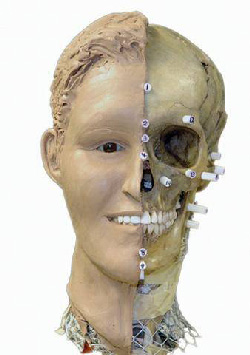by Jan Kalina
Common methods of 2D image analysis in anthropological and biomedical applications are too sensitive to the presence of artifacts or outliers in the data. We study robust statistical methods suitable for high-dimensional information processing. The results acquired from practical anthropological and biomedical tasks demonstrate the benefits of methods based on robust statistics.
{jcomments on}Standard methods of image analysis applied to forensic anthropology or biomedicine (for example, analysis of medical ultrasound images) are not robust. Typical procedures start with a dimension reduction and feature extraction and proceed to a machine learning method (for example neural networks, support vector machines or Bayesian classification). Robust mathematical statistics demonstrate that these methods are non-robust in terms of their vulnerability to outlying values. Individual classifiers are often combined with ad hoc procedures to create complex black box systems with numerous parameters, rendering impossible a simple interpretation. The noise plays a highly influential role in the information extraction from images and the methods are also sensitive to two-dimensional artifacts or to specific assumptions which cannot be verified.
In the Centre of Biomedical Informatics (project of the Ministry of Education, Youth and Sports of the Czech Republic) we propose robust approaches for 2D image analysis. Robust statistical methods bring new insights to image analysis problems as well as being very appropriate to meet their specific requirements. We apply new robust statistical methods and algorithms to the analysis of real data in anthropology and biomedicine. One of the aims is a denoising of 2D images, for which we propose a robust filter based on local smoothing by robust regression. Further, we propose a robust machine learning procedure based on a new estimator of location and scatter for multivariate data. Reflecting the most recent developments of robust statistics, the method possesses a high breakdown point, which is a statistical measure of sensitivity against outliers or noise in the data. This technique has desirable properties including robustness to noise, reliability for a high dimension of the data, computational stability, clear interpretation and model selection.

Figure 1: Forensic anthropology aims to identify crime victims. The superprojection compares the skull with 2D photographs of missing persons.
The motivation for the anthropological research is a distant aim to examine the connection between the size and shape of facial features and the genetic code. The basic task of anthropometrics is person identification, which can be interpreted as a statistical problem of analysis of variability. Namely, we work in face recognition, comparing the image of a person with images in a database and the inter-person variability must be differentiated from intra-person variability. Anthropometric measures in the face allow also the diagnosis of genetic diseases based on a craniofacial dysmorphism.
In the task of face detection, each face must be automatically localized in the image. This is again a problem of machine learning, because each part of an image is classified as a face or a non-face. We carry out the face detection by detecting symmetrical areas within an image. Symmetry is measured between two neighbouring rectangular areas in the images using a new robust correlation coefficient, which down-weights regions of the face violating the symmetry. It also yields reliable results in face localization for faces which are not entirely symmetrical. Further, we have developed a robust nonparametric discrimination technique allowing location of facial landmarks, which are biologically defined points of correspondence in each face. The use of optimal templates in face detection ensures the results to be resistant to severe noise in the image, occlusion of the face, illumination changes, asymmetric hair style or rotation of the face.
The results of 2D image analysis of faces also have applications to forensic anthropology. In this area we intend to implement a 3D image analysis method for forensic analysis of skulls and faces. Geometric morphometrics based on a certain point of landmarks is commonly used to compare a skull of a crime victim with a 2D image of the face of a missing person. Here we propose to objectify the specification of landmarks. For the sake of morphometric analysis, we will perform an optimization procedure involving the computation of weights for individual landmarks for a training set of skulls and images of the face. This will enable us to maximize the discrimination between the image corresponding to the particular skull and all other images. Robust statistical methods are underlaid by profound theoretical reasoning and yield very promising and reliable results in anthropological and biomedical applications.
Link: http://www.euromise.org
Please contact:
Jan Kalina, Centre of Biomedical Informatics, Institute of Computer Science, Academy of Sciences of the Czech Republic / CRCIM
Tel.: +420 266053099
E-mail:










